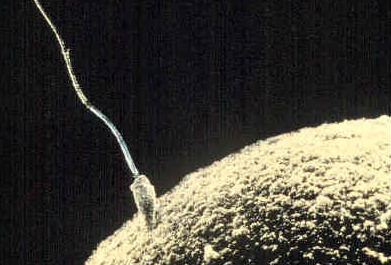2.36 缓解
章节大纲
-
What will you learn
::你会学到什么-
The process of meiosis
::肾上腺化过程 -
Different phases of meiosis
::不同诊断阶段 -
How
crossing over
happens during meiosis
::流行病期间如何跨越过境点
How do you make a cell with half the DNA?
::你如何用半个DNA做细胞?Meiosis. This allows to have half the number of , so two of these cells can come back together to form a new organism with the complete number of chromosomes. This process not only helps produce gametes , it also ensures .
::Meisisis 。 这样可以拥有一半的 数, 这样其中两个细胞可以回到一起 形成一个新的有机体, 染色体的完整数量。 这个过程不仅有助于生成调子, 而且还能确保 。Meiosis
::诊断The process that produces haploid gametes is meiosis. Meiosis is a type of in which the number of chromosomes is reduced by half. Meiosis is specific to gamete producing cells in the gonads . Meiosis begins with a diploid cell and ends with four haploid cells. These cells eventually differentiate into mature or egg cells. During meiosis, homologous chromosomes separate, and haploid cells form that have only one chromosome from each pair. Two cell divisions occur during meiosis, meiosis I and meiosis II.
::生成杂交调色板的过程是 meiosis 。 Meisis 是一种将染色体数量减半的过程。 美化是用来生成花生细胞的。 美化始于一个浸泡细胞, 末端为四个杂交细胞。 这些细胞最终会分化成成熟的或蛋的细胞。 在微化过程中, 将同族染色体分离出来, 以及每对染色体只有一种染色体的杂交细胞形式。 两种细胞分解在肾上、 美化I 和 meiscois II 期间发生。Phases of Meiosis
::Meisisid 阶段Meiosis I begins after replicates during interphase of the . In both meiosis I and meiosis II, cells go through the same four phases as - prophase , metaphase , anaphase and telophase . However, there are important differences between meiosis I and mitosis. The animation below shows what happens in both meiosis I and II.
::Meisisis I 是在中间阶段的复制后开始的。在中间阶段一和中间阶段二中,细胞经历与前阶段、前阶段、前阶段、前阶段、前阶段和中阶段相同的四个阶段。但是,在中间阶段一和后阶段之间有重大差异。下面的动画显示了在中间阶段一和二中发生的情况。How does meiosis I differ from mitosis? Notice at the beginning of meiosis (prophase I), homologous chromosomes exchange segments of DNA. This is known as crossing over , and is unique to this phase of meiosis.
::“我与分裂症有什么不同呢?”在开始出现分裂症(前期一)时注意到,同质染色体交换DNA的分块。这被称为交叉,是这一阶段的独有。Meiosis I
::诊断一-
Prophase I: The
nuclear envelope
begins to break down, and the chromosomes condense.
Centrioles
start moving to opposite poles of the cell, and a
spindle
begins to form. Importantly, homologous chromosomes pair up, which is unique to prophase I. In prophase of mitosis and meiosis II, homologous chromosomes do not form pairs in this way. Crossing over occurs during this phase.
::第一期:核子封套开始破裂,染色体开始凝结。三联体开始向细胞对面的极点移动,并开始形成一个螺旋形。重要的是,同质染色体配对,这是第一期的独有。在二号线性分裂和梅氏病的预期中,同质染色体不会以这种方式形成对体。在这一阶段,交叉会发生。 -
Metaphase I: Spindle fibers attach to the paired homologous chromosomes. The paired chromosomes line up along the equator (middle) of the cell. This occurs only in metaphase I. In metaphase of mitosis and meiosis II, it is sister chromatids that line up along the equator of the cell.
::元阶段一: 配对的同族染色体附着的斯宾德尔纤维。 配对的染色体排在细胞赤道( 中间) 上。 这只在元阶段一中发生。 在肾上腺素和梅毒的元阶段二中, 是姊妹染色体排在细胞赤道上。 -
Anaphase I: Spindle fibers shorten, and the chromosomes of each homologous pair start to separate from each other. One chromosome of each pair moves toward one pole of the cell, and the other chromosome moves toward the opposite pole.
::分析阶段一:斯宾德尔纤维缩短,每对同父异父异母的染色体开始分离。每对同父异母的染色体有一个染色体移向细胞的一根杆,另一个染色体移向对立杆。 -
Telophase I and
Cytokinesis
: The spindle breaks down, and new nuclear membranes form. The
cytoplasm
of the cell divides, and two haploid
daughter cells
result. The daughter cells each have a random assortment of chromosomes, with one from each homologous pair. Both daughter cells go on to meiosis II. The DNA does not replicate between meiosis I and meiosis II.
::Teloprophy I 和 Cytokinesis: 脊椎破裂, 新的核膜形式。 细胞分裂的细胞图象, 以及两只破碎的女儿细胞结果。 女儿细胞各有染色体的随机分布, 每对同系一对。 两个女儿细胞都使用线状二。 DNA不能在美化一和美化二之间复制。
Meiosis II
::诊断二-
Prophase II: The nuclear envelope breaks down and the spindle begins to form in each haploid daughter cell from meiosis I. The centrioles also start to separate.
::第二阶段:核封套破裂,脊柱开始形成 每一个从中度I 的软体女儿细胞。 圆锥也开始分离。 -
Metaphase II: Spindle fibers line up the sister chromatids of each chromosome along the equator of the cell.
::代号二:斯宾德尔纤维排列在细胞赤道沿线每个染色体的姐妹色谱。 -
Anaphase II: Sister chromatids separate and move to opposite poles.
::分析阶段二:姐妹染色体分离,移到对极。 -
Telophase II and Cytokinesis: The spindle breaks down, and new nuclear membranes form. The cytoplasm of each cell divides, and four haploid cells result. Each cell has a unique combination of chromosomes.
::电波II和Cytokinesis: 螺旋断裂, 新的核膜形式。 每个细胞的细胞分裂和四个手动细胞结果。 每个细胞都有独特的染色体组合。
Summary
::摘要-
Meiosis is the type of cell division that produces gametes.
::Meisisis 是产生数子的细胞分裂类型。 -
Meiosis involves two cell divisions and produces four haploid cells.
::诊断涉及两个细胞分裂,产生四个散居的细胞。 -
Sexual reproduction has the potential to produce tremendous genetic variation in offspring. This is due in part to crossing over during meiosis.
::性生殖有可能在后代中产生巨大的遗传变异,部分原因是在宫颈病期间跨越。
Review
::回顾-
What is meiosis?
::什么是肾上腺素? -
Compare the events of metaphase I to metaphase II?
::将第一阶段与第二阶段相比? -
Create a diagram to show how crossing over occurs and how it creates new gene combinations on each chromosome.
::创建一个图表, 显示如何交叉交叉, 以及如何在每一个染色体上创造新的基因组合 。 -
Explain why sexual reproduction results in genetically unique offspring.
::解释为什么性生殖导致遗传上独特的后代。 -
Explain how meiosis I differs from mitosis.
::解释一下我和脑膜硬化有什么不同
-
The process of meiosis
